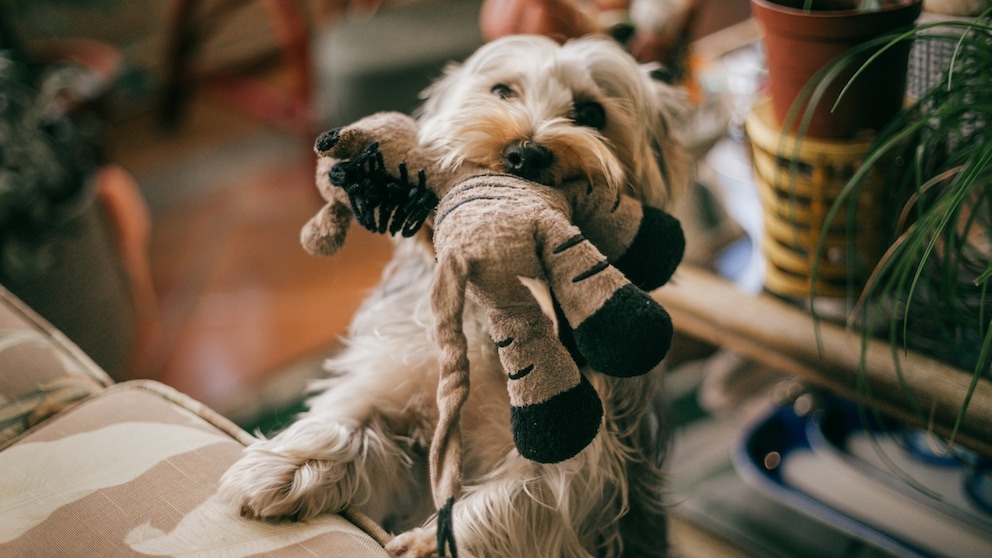April 9, 2025, 9:58 am | Read time: 5 minutes
Does your dog drag balls and toys to you as soon as you are sitting comfortably on the couch? Many believe that their four-legged friend wants to show them that it wants to play. But this is not always true. Dog trainer Torsten Bencke reveals what lies behind this behavior.
A ball, a stuffed animal, or their favorite bone — does your dog bring you a toy as soon as you come home? What pleases many owners is perhaps less sweet and enjoyable than expected. At least if the London dog trainer behind the account “Howl School for Dogs” is right. In an Instagram video, she explains to owners that dogs mainly fetch toys when they are stressed: Retrieving is less about the play instinct and more about emotional self-regulation, she says. Is that really the case?
PETBOOK asked dog trainer Torsten Bencke. The Hamburg-based trainer has been working with dogs for over 20 years and cannot confirm this theory. “For me, this is a typical example of someone putting forward a theory to get attention,” he says about the video. “The dog you see here doesn’t look stressed at all.”
“Sharing Is Caring” — A Sign of Affection?
According to Torsten Bencke, bringing objects is often simply an expression of joy and solidarity: the most valuable things are shared and entrusted to the owner. “That’s exactly what you want to create in a dog,” he explains. Dogs are naturally social creatures that are designed to cooperate. Many dogs bring things to their owners because they have learned that this elicits a positive response — be it through attention, praise, or a shared game.
The Importance of “Retrieving Loyalty”
“What you see here is a kind of retrieving loyalty,” says Torsten Bencke. Retrieving reliability plays a significant role in hunting dog work, where it refers to a dog’s ability to consistently bring a found object back to its owner. Most of today’s breeds are descended from hunting dogs that were bred to retrieve shot prey and bring it back undamaged, recalls Torsten Bencke, who keeps hunting dogs himself. “Dogs such as poodles, spaniels, and even labradors have been selected for centuries to exhibit precisely this behavior,” says the Hamburg dog trainer.
This predisposition is still deeply rooted in the genes of many dog breeds today — not only in classic hunting dogs but also in many mixed breeds. A labrador that brings its owner a ball is, therefore, following an innate behavior and is simply doing what the dog should and wants to do.
Hunting dogs, therefore, follow their instinct when retrieving and bringing objects and are doing something completely natural. But what about dogs that have not been bred specifically for retrieving? Probably similar because, for dogs, retrieving an object is a meaningful activity that provides mental and physical exercise.
Can There Still Be Stress Behind the Behavior?
But what about the theory that dogs use retrieving to relieve stress? In fact, this can be true in some cases — but not always in a negative sense. Stress is not automatically bad, as Bencke explains: “The fact that stress is so negative is due to the meaning we give it as humans. A dog that has a task — for example, to search for and retrieve an object — experiences a form of positive stress. He is given a task that he wants to fulfill, which challenges him mentally and gives him a structure.”
Perhaps we can imagine a dog that seems a little stressed when bringing its favorite toy, like a person who likes to solve puzzles or play sports. Short-term activation is beneficial for well-being as long as it doesn’t turn into permanent, negative stress. That probably doesn’t sound dramatic enough for an Instagram video that you hope will go viral.
Is the Dog Stressed When It Brings a Toy? How to Recognize It
If you’re still concerned that your dog is bringing objects out of insecurity or nervousness, you should watch for other symptoms, including these:
- Panting without physical exertion
- Yawning even though the dog is not tired
- Excessive licking of their lips
- Pinched tail or crouched posture
If you notice such signs in your dog, it may be useful to consult an expert to analyze whether the behavior is actually due to stress.
Should You Prevent Your Dog from Bringing Toys?
Whether or not to encourage fetching depends on your personal preference and the dog in question. In principle, the behavior is neither problematic nor does it need to be retrained — on the contrary. If your dog happily brings you a toy, you can reward this with positive attention or a game together.
However, if your dog drags objects around excessively and seems nervous, it may be useful to offer alternative activities to reduce stress. The following are just some of the possibilities:
- Nose games: Hide treats or toys for your dog to find.
- Tugging games: Some dogs relieve tension through pulling and tugging games.
- Chew toys: Prolonged chewing can have a calming effect.
- Calm stroking: Some dogs relax through physical contact.

Why cats continuously throw things off the table

Study shows that cats retrieve more often than expected

How to Recognize Whether Your Dog is Particularly Intelligent
Conclusion
In most cases, a dog bringing toys to its owner is a sign of joy and social bonding and rarely a sign of stress. Especially breeds with a predisposition to fetch show this behavior instinctively. Even if dogs occasionally put objects in their mouths in stressful situations, this does not mean that they are “stressed” in the human sense.

